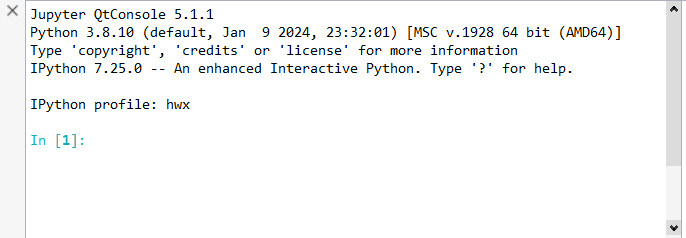Getting Started
Learn how to get started using the Python API.
Launch the Python Console in MotionView
- Launch a new MotionView session.
- Click .The Python Console window is launched.
Figure 1. 
Python Console Conventions

Importing mview Package
In order to create, modify, and interact with the MotionView
modeling entities through python, the mview package needs to be imported
first.
>>> from hw import mviewCreating and Modifying Entities
Try out the following commands in the python console:
- Creating Entities
-
>>> from hw import mview# import mview package >>> p1 = mview.Point(name="p_0", x=1, y=4, z=3)# creates a point >>> b1 = mview.Body(name="Body1")# creates a body >>> m1 = mview.Marker(name="Marker1",body=b1,origin=p1)# creates a marker at origin p1 and on body b1 - Accessing Attribute Values
- The dot operator (.) is used to "get" or access class attribute values. You can also
use a getValue function to do the same. These values can be used in
other python expressions. The examples below illustrates this.
>>> p = mview.Point(name="p_0", x=1, y=4, z=-2)# Create a point >>> p.x 1.0# Get x coordinate of a point >>> p.name 'p_0'# Get variable name of the point >>> b = mview.Body(name="b_0", mass=1000, ixx=200, iyy=300, izz=400, cg=p)# Create a body with its cg at location of point p1 >>> b.cg <hw.mview.mbd.Point.Point object at 0x00000162DEB8E940># Get value of the cg, returns the handle of the point it points to >>> b.cg.name 'p_0'# Get the name of this point - Modifying Attribute Values
- In a similar way, you can modify attribute values through dot notation or a
setValue function.
>>> p.y = 2 >>> p.y 2.0# Modify the "y" coordinate value of point "p_0" created previously >>> p.setValue('z', 12) True >>> p.z 12.0# Use setValue function to change "z" coordinate value. Returns True on successfully setting the value >>> b.cg = "P_Global_Origin" >>> b.cg.name 'P_Global_Origin'# Assign the Global Origin to the "cg" of body "b_0" >>> p.setValues(x=11, y=22, z=33) >>> p.x 11.0 >>> p.y 22.0 >>> p.z 33.0# Use setValues function to change multiple values at a time Note: While assigning value to a property which expects an entity reference, for example the cg property of a body, either the full variable name of the entity or the python handle of that entity can be used. - Assign Parametric Values to Attributes
- To assign values which are dependent on properties of other entities, use the full
varname of that property as below.
>>> p1 = mview.Point( name='p_1', x=3, y=3, z=3) >>> p2 = mview.Point( name='p_2', x=2) >>> p2.x = "p_1.x" >>> p2.x 3.0# x coordinate of p2 is expressed in terms of x coordinate of Point p_1 (Parametric expression is given as a string) >>> p1.x = 12 >>> p2.x 12.0# Changing x coordinate of p1 changes x coordinate of p2 - Getting Python Handles of Entities
- To get the python handle to the entity from its variable name use the function
getObjectFromPath().
>>> from hw import mview >>> p = mview.getObjectFromPath("MODEL.System_1.Point_1") >>> p.name 'Point_1' >>> p.parent <hw.mview.mbd.System.System object at 0x00000201C9DF0128># get the handle of a point "Point_1" in "System_1" which is already created You can also get the handle of an entity using the getModel() function which gets the model.>>> p1 = mview.getModel().System_1.Point_1 >>> p1.name 'Point_1'# get the handle of a point "Point_1" in "System_1" which is already created using getModel() function
Saving, Opening, and Exporting Models
To save a model as an mdl file, use the writeFile method on the mview
class (see the example
below):
>>> from hw import mview
>>> mview.writeFile(r"C:/Temp/example.mdl")
To export a model to a MotionSolve xml file, use the
writeFile
function:
>>> mview.writeFile(r"C:/Temp/example.xml")To open an mdl file or a python script, use the readFile
function:
>>> mview.readFile(r"C:/Temp/example.mdl")Use the runSolverScript function to run a solver script:
>>> mview.runSolverScript(r"C:\Altair\Examples\gearpair1.xml")Python Console Tips and Tricks
- The console can be cleared using the shortcut "Ctrl+Shift+L" or %clear.
- Try <Tab> for an auto-complete suggestion for a function or property name.
Running Python Scripts
A python script can be executed by any of the following three methods:
- Click .
OR
- Use the standard python function in the
console.
>>> exec(open(r"C:/Users/username/myscript.py").read())OR
- Use %run command in the
console.
>>> %run C:/Temp/Examples/test.pyNote: %run is not a standard python command.
Command Logging
You can log the commands you type in the Python console as follows:
- Go to .
- Select the General tab under MotionView.
- Click on the Python command logging check box.
- Provide a log file to save.